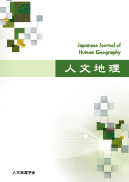Volume 72, Issue 3
Displaying 1-30 of 30 articles from this issue
- |<
- <
- 1
- >
- >|
Research Note
-
2020Volume 72Issue 3 Pages 191-209
Published: 2020
Released on J-STAGE: October 27, 2020
Download PDF (1684K)
2019 Annual Review
-
2020Volume 72Issue 3 Pages 211-214
Published: 2020
Released on J-STAGE: October 27, 2020
Download PDF (772K) -
2020Volume 72Issue 3 Pages 215-218
Published: 2020
Released on J-STAGE: October 27, 2020
Download PDF (772K) -
2020Volume 72Issue 3 Pages 219-223
Published: 2020
Released on J-STAGE: October 27, 2020
Download PDF (777K) -
2020Volume 72Issue 3 Pages 224-227
Published: 2020
Released on J-STAGE: October 27, 2020
Download PDF (759K) -
2020Volume 72Issue 3 Pages 228-231
Published: 2020
Released on J-STAGE: October 27, 2020
Download PDF (790K) -
2020Volume 72Issue 3 Pages 232-236
Published: 2020
Released on J-STAGE: October 27, 2020
Download PDF (777K) -
2020Volume 72Issue 3 Pages 237-240
Published: 2020
Released on J-STAGE: October 27, 2020
Download PDF (772K) -
2020Volume 72Issue 3 Pages 241-244
Published: 2020
Released on J-STAGE: October 27, 2020
Download PDF (793K) -
2020Volume 72Issue 3 Pages 245-248
Published: 2020
Released on J-STAGE: October 27, 2020
Download PDF (773K) -
2020Volume 72Issue 3 Pages 249-252
Published: 2020
Released on J-STAGE: October 27, 2020
Download PDF (759K) -
2020Volume 72Issue 3 Pages 253-256
Published: 2020
Released on J-STAGE: October 27, 2020
Download PDF (772K) -
2020Volume 72Issue 3 Pages 257-261
Published: 2020
Released on J-STAGE: October 27, 2020
Download PDF (778K) -
2020Volume 72Issue 3 Pages 262-266
Published: 2020
Released on J-STAGE: October 27, 2020
Download PDF (763K) -
2020Volume 72Issue 3 Pages 267-269
Published: 2020
Released on J-STAGE: October 27, 2020
Download PDF (790K) -
2020Volume 72Issue 3 Pages 270-273
Published: 2020
Released on J-STAGE: October 27, 2020
Download PDF (758K) -
2020Volume 72Issue 3 Pages 274-278
Published: 2020
Released on J-STAGE: October 27, 2020
Download PDF (775K) -
2020Volume 72Issue 3 Pages 279-282
Published: 2020
Released on J-STAGE: October 27, 2020
Download PDF (772K) -
2020Volume 72Issue 3 Pages 283-286
Published: 2020
Released on J-STAGE: October 27, 2020
Download PDF (773K) -
2020Volume 72Issue 3 Pages 287-290
Published: 2020
Released on J-STAGE: October 27, 2020
Download PDF (760K) -
2020Volume 72Issue 3 Pages 291-294
Published: 2020
Released on J-STAGE: October 27, 2020
Download PDF (774K) -
2020Volume 72Issue 3 Pages 295-298
Published: 2020
Released on J-STAGE: October 27, 2020
Download PDF (759K)
Focus
-
2020Volume 72Issue 3 Pages 299-315
Published: 2020
Released on J-STAGE: October 27, 2020
Download PDF (846K)
Book Reviews
-
2020Volume 72Issue 3 Pages 316-317
Published: 2020
Released on J-STAGE: October 27, 2020
Download PDF (718K) -
2020Volume 72Issue 3 Pages 318-319
Published: 2020
Released on J-STAGE: October 27, 2020
Download PDF (718K) -
2020Volume 72Issue 3 Pages 320-321
Published: 2020
Released on J-STAGE: October 27, 2020
Download PDF (719K) -
2020Volume 72Issue 3 Pages 322-323
Published: 2020
Released on J-STAGE: October 27, 2020
Download PDF (720K) -
2020Volume 72Issue 3 Pages 324-325
Published: 2020
Released on J-STAGE: October 27, 2020
Download PDF (719K) -
2020Volume 72Issue 3 Pages 326-327
Published: 2020
Released on J-STAGE: October 27, 2020
Download PDF (717K)
Information from the society
-
2020Volume 72Issue 3 Pages 328-335
Published: 2020
Released on J-STAGE: October 27, 2020
Download PDF (751K)
- |<
- <
- 1
- >
- >|
